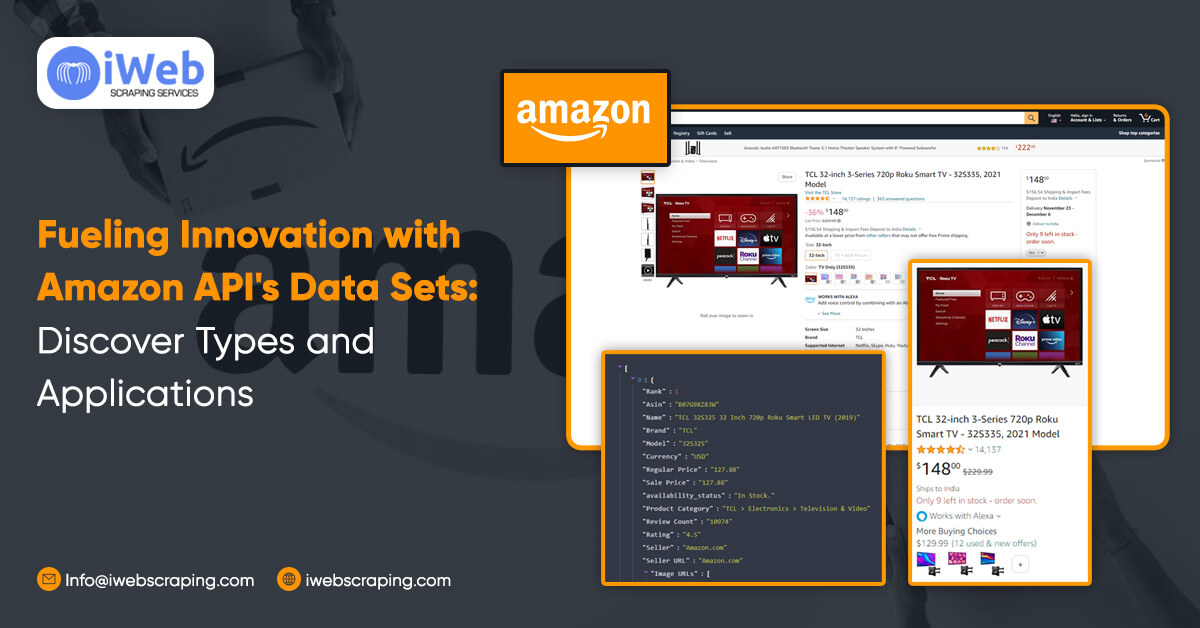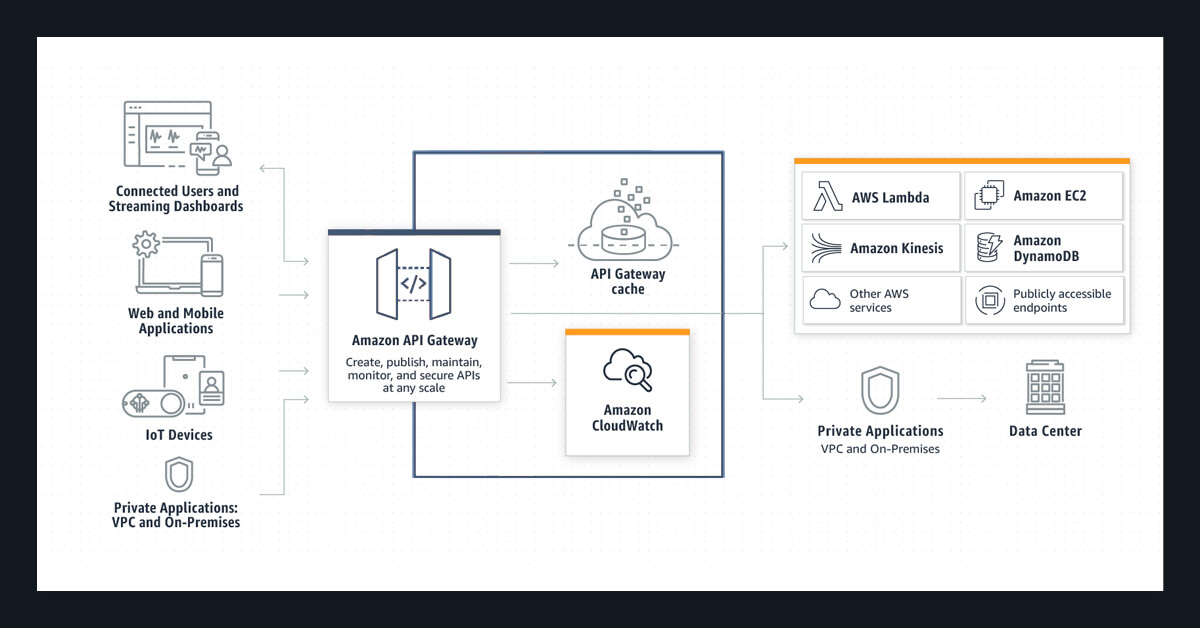Fueling Innovation with Amazon API's Data Sets: Discover Types and Applications
Amazon's online shopping offers several data sets and APIs useful for retailers. Amazon's data sets provide a glimpse into the patterns of online shoppers worldwide. They can be used to discover insights into products and services in different demographics. So companies can better compete.
This article will examine some of these data sets and the use cases people have discovered behind them.
How has Amazon changed the shopping landscape?

Amazon is the most extensive online shopping that has changed the online shopping landscape. They have become an Internet staple when you visit their website. You get into an hour of Amazon surfing. Their success has not gone unnoticed, though. Several companies have tried replicating their business model and gained market traction.
What has made Amazon so successful on the Internet? A competitive pricing , great service, and, of course, a vast selection of products. While these are all great reasons to shop at Amazon, they are the reasons it has so many competitors.
But what can other online retailers do to compete with Amazon? How do they get more customers? Many companies have tried and failed to use those tactics that worked so well for others. Others have tried to find new ways to stay competitive, and that is where the Amazon data sets come into play.
Understanding Amazon API

Amazon has many APIs allowing customers to consume site data sets. These data sets include the products listed on their website. It offers the sales of those products, where they are sold, and what is sold with them.
It provides customers with a wealth of targeted information. The Amazon API client libraries allow developers to create software that can use this information.
Amazon offers APIs that allow companies to store or retrieve their inventory. For example, a jewelry website might be interested in keeping the merchandise in its warehouse. It offers an API for creating a "Delta Delivery" service. "Delta Delivery" protects online retailers from delivering and receiving inventory different from each other. It allows them to adjust the inventory in real time.
Amazon API's Data Sets
Amazon allows companies to publish their data sets in the Amazon Data Store. It is possible to use all of their data sets for free.
1. Sales Rank Historical Graph.
From early in Amazon's life, the company has offered customers a ranking system to measure the popularity of certain products. The sales rank is based on orders made over the last four weeks. This sales rank is the metric that Amazon has published as an API. It allows retailers to understand better how their products are selling on Amazon. This graph gives a more detailed look at how sales rank tracks sales. It can help determine what product lines are worth expanding or need to be scaled back.
2. Amazon Product Advertising API.
Amazon's advertising API enables companies to reach out to potential customers and reach them on Amazon. This allows retailers to create targeted advertisements based on criteria such as the geographic location of the consumer, their gender, or even the age group. The advertisements can then be delivered within the Amazon website or app.
Amazon has been disrupting traditional online retail for years and is on top of new technologies and business model developments to keep moving forward.
3. Amazon Marketplace Web Service (MWS)
The Amazon MWS service enables retailers to upload and manage their inventory and the products sold on their websites. This information makes it easier for people to see what items are available. It shows whether the item is available with Prime shipping.
4. Selling on Amazon (SOA)
The Selling on Amazon API gives users access to a seller's account information and any sales they have made. The API will return any past purchases, profit margins, profits, sales tax, and shipping fees charged on each order. This API can automate the collection and reporting of sales reports.
5. Inventory Management (IM)
The inventory API allows developers to integrate their existing software with Amazon's to keep track of items sold on the site. For example, if a customer has purchased a pair of shoes through your online store, this API will tell you whether the stock is available on Amazon. It means you know how much it costs and where it is located to simplify ordering from your distributor or the manufacturer.
6. Amazon Product Advertising API (Prepaid Authorization)
This API allows third-party companies to create product ads on Amazon and is used to help keep the ads relevant. Using this API, retailers can determine which products are selling well and which ones are not. It lets companies know which products to advertise to their target audience. This API is handy if a company wants to promote its products by location or country information.
7. Amazon Advertising (AD)
Amazon's advertising API allows retailers to sign up for site ads before buying them. Then choose when those ads are delivered to customers when they add the item to their basket online. This API has been designed to help companies and online advertisers. To better understand what they can expect from their campaigns.
What are the Applications of Amazon API's Data Sets?
Amazon API's Data Sets provide various data sets that can be used in multiple ways. Below are a few examples of using these data sets in the modern digital economy.
1. Inventory Management:
Amazon allows users to publish and update their inventory. This API will enable retailers to monitor and control their inventory. Determining what products sell well on Amazon is vital to every retailer's business. An inventory management system will allow online retailers to ensure they are competitive against competitors.
2. Selling on Amazon:
Merchants will find that using the selling on Amazon API can be useful if they have the inventory they want to sell on Amazon. By using this API, a merchant can list their product information, including the price, condition, size, and color of an item, all at once. It can be helpful for merchants with a lot of inventory to sell.
4. Inventory Management with Order Fulfillment:
Many online shopping platforms allow users to sell their product inventory through their websites. Using the inventory management API, manufacturers can list their products and ship them to Amazon when a customer has added the item to a shopping cart and is ready to check out.
Once the item is shipped, Amazon will notify the merchant, and they will receive an invoice from them to pay for the shipment. Amazon handles fulfillment costs such as insurance, packaging, shipping, tracking numbers, etc.
5. Replenishment:
Using this API, a retailer can have Amazon-provided information regarding the clearance status of any items on backorder or out of stock. It will allow them to remain competitive in their marketplace. This data will enable a retailer to determine how much to order and when to replenish inventory from an Amazon vendor.
Types of Data Available on Amazon
The following data types are supported:
1. AccessLogSettings:
Amazon's AccessLogSettings data type enables users to maintain a log of their Amazon API calls and return errors or debug messages by setting individual fields or specific error codes.
2. SoldItems:
Amazon's Sold Items data type stores information on items sold in a retailer's inventory. It includes the item's SKU, price, amount sold and date of sale.
3. SoldDetails:
Amazon's Sold Details data type stores information on items sold in a retailer's inventory. It includes the item's SKU, price, amount sold and date of sale. The data will be split into two buckets:
DataPoints and FieldsToReturnPairs. The former is used for all variables where Amazon returns multiple values, while the latter is used for all variables where Amazon returns just one value.
4. SoldItemsResponse:
Sold Items Response is Amazon's data type that stores response data for PastSaleItem requests.
5. CustomerReview:
Amazon's Customer Review data type stores information about customer reviews for a product on Amazon. It includes the review's rating, comment text, name, and link to the review.
6. Derivatives:
Amazon's Derivatives data type stores information about a product's derivatives, which are products based on or related to another product in some way. It is helpful if a user wants to get more of an item they are selling or to avoid overlapping similar items in inventory between different sales channels (like Amazon).
7. InventoryStatus:
Amazon's Inventory Status data type stores information about the inventory levels of a product on Amazon. It includes the item's SKU, quantity available for sale, and quantity available for immediate purchase.
There are various data types available on Amazon. The APIs can be used to access or integrate with the Service. Amazon maintains separate categories of RESTful APIs, grouped by service area, including those for developers, professional services providers, enterprise applications, and others.
Conclusion:
Amazon has designed its APIs with specific business needs. Merchants can utilize numerous data sets for various reasons from this platform. Large or small retailers must use these tools to help them manage their business on Amazon. In addition, the freemium model of these APIs makes them much more affordable and accessible for retailers.




